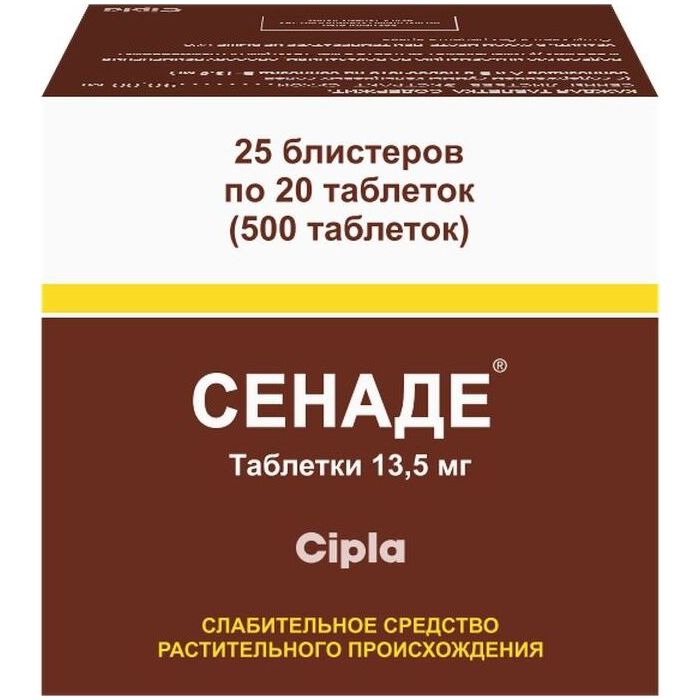Senade tab. 13.5 mg # 500
Category
Laxatives
Scope of the medicinal product
Gastrointestinal tract
Release form
Tablet
Manufacturer country
India
Package quantity, pcs
500
Dosage form
Flat round tablets with beveled edges from brown to dark brown interspersed.
On one side of the tablet is the word CIPLA", on the other - a fracture line.
Structure
Each tablet contains:
Leaf sennoside extract .... 93.33 mg (containing the sum of calcium salts of sennosides A and B in terms of sennoside B - 13.5 mg)
Excipients: lactose - 23.07 mg, starch - 43.56 mg, methyl parahydroxybenzoate - 0.04 mg, microcrystalline cellulose - 15.0 mg, talc - 11.13 mg, magnesium stearate - 0.93 mg, sodium lauryl sulfate - 0.93 mg, sodium carmellose 2.00 mg.
pharmachologic effect
Has a laxative effect, which occurs after 8-10 hours.
The laxative effect is due to the effect on the receptors of the large intestine, which enhances peristalsis.
Pharmacokinetics
In accordance with the International Convention (EMEAHMPWG11 / 99), when conducting clinical trials of herbal preparations, an isolated study of pharmacokinetic parameters is not required
Side effects
The laxative effect of the drug may be accompanied by colicky abdominal pain, flatulence.
With prolonged use, especially in high doses, water-electrolyte metabolism disorders, albuminuria, hematuria, melanin deposition in the intestinal mucosa, nausea, vomiting, diarrhea, urinary discoloration, skin rash, convulsions, vascular collapse, fatigue, confusion are possible.
Selling features
Available without a prescription
Special conditions
It is not recommended to use the drug for more than 2 weeks.
After taking the drug, urine may acquire a yellow-brown or red-lilac color.
Indications
constipation caused by hypotension and sluggish peristalsis of the large intestine
stool regulation for hemorrhoids, proctitis, anal fissures
Contraindications
Hypersensitivity to the components of the drug, spastic constipation, intestinal obstruction, abdominal pain of unknown origin, strangulated hernia, acute inflammatory diseases of the abdominal cavity, peritonitis, gastrointestinal and uterine bleeding, cystitis, disorders of water and electrolyte metabolism.
Drug interactions
With long-term use of Senade® in high doses, it is possible to increase the action of cardiac glycosides and influence the action of antiarrhythmic drugs due to the possibility of hypokalemia.
With simultaneous use with thiazide diuretics, glucocorticoids, licorice root preparations, the risk of hypokalemia increases.
Dosage
It is taken internally, usually 1 time per day in the evening before bedtime, washed down with water or any drink.
Adults and children over 12 years old: 1 tablet per dose.
If there is no effect, the dose can be increased to 2-3 tablets.
Children 6-12 years old: 1/2 tablet and, if necessary, increase the dose to 1-2 tablets.
In the selection process, the same dose should be taken over several days and gradually increased by 1/2 tablet.
If, after reaching the maximum dose, there is no bowel movement within 3 days, a doctor should be consulted.
Overdose
diarrhea leading to dehydration
Name ENG
SENADE
Clinical and pharmacological group
Laxative drug that stimulates intestinal motility
ATX code
Senna glycosides
Dosage
1 tab.
- senna leaf extract 93.33 mg, containing the sum of calcium salts of sennosides A and B in terms of sennoside B 13.5 mg
Structure
Leaf sennoside extract. 93.33 mg (with the content of the sum of calcium salts of sennosides A and B in terms of sennoside B - 13.5 mg).
Excipients: lactose - 23.07 mg, starch - 43.56 mg, methyl parahydroxybenzoate - 0.04 mg, microcrystalline cellulose - 15.0 mg, talc - 11.13 mg, magnesium stearate - 0.93 mg, sodium lauryl sulfate - 0.93 mg, sodium carmellose 2.00 mg.
Indications
constipation caused by hypotension and sluggish peristalsis of the large intestine
stool regulation for hemorrhoids, proctitis, anal fissures.
INN / Active ingredient
sennosides A and B calcium salts (in terms of sennoside B)
Storage conditions and periods
The drug should be stored out of the reach of children, in a dry place at a temperature not exceeding 30 ° C.
The shelf life is 3 years.
Contraindications
spastic constipation
intestinal obstruction
abdominal pain of unknown origin
strangulated hernia
acute inflammatory diseases of the abdominal cavity
peritonitis
gastrointestinal and uterine bleeding
cystitis
violations of water and electrolyte metabolism
hypersensitivity to drug components.
It is prescribed with caution for liver and / or kidney diseases, during pregnancy, during breastfeeding, in conditions after abdominal operations.
Specifications
Category
Laxatives
Scope of the medicinal product
Gastrointestinal tract
Release form
Tablet
Manufacturer country
India
Package quantity, pcs
500
Minimum age from
6 years
Way of introduction
Through the mouth
Vacation conditions
Without recipe
Brand name
Cipla
The amount of the dosage form in the primary package
20 pcs.
Primary packaging type
Blister
Type of consumer packaging
Pack of cardboard
Pharmaco-therapeutic group
Herbal laxative
Anatomical and therapeutic characteristics
A06AB06 Sennosides A and B
Dosage form
Pills
Expiration date in days
36
The target audience
Children
Package weight, g
360
Mode of application
:
It is taken internally, usually 1 time per day in the evening before bedtime, washed down with water or any drink.
Dosage (volume) of the substance in the preparation
:
1 tab.
- senna leaf extract 93.33 mg, containing the sum of calcium salts of sennosides A and B in terms of sennoside B 13.5 mg
Information on technical characteristics, delivery set, country of manufacture "

